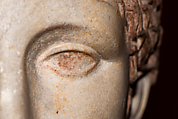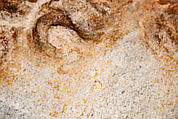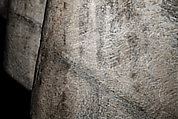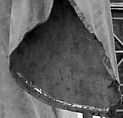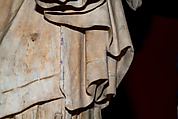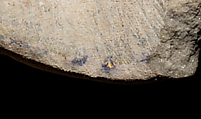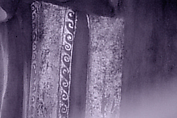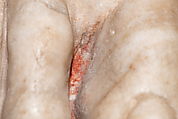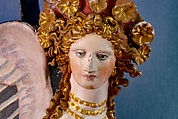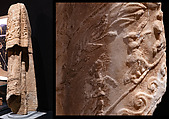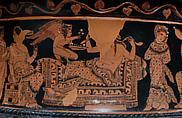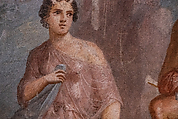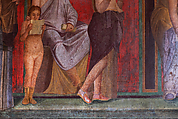Returned to lender The Met accepts temporary loans of art both for short-term exhibitions and for long-term display in its galleries.
Reconstruction of a marble statue of a woman wrapping herself in a mantle (so-called Small Herculaneum Woman)
Vinzenz Brinkmann German
Ulrike Koch-Brinkmann
Not on view
"The Late Classical prototype of the so-called Small Herculaneum Woman is lost, but dozens of copies of the Hellenistic and Roman periods are preserved. The young woman, her hair composed of several strands woven together into a severe bun, wraps herself in a mantle that she draws tightly around her body with both hands. Beneath the mantle she wears a finely pleated undergarment and sandals with thick soles. The reconstruction was made in 2019, as part of a project financed by the Federal Ministry for Education and Research, "The university collection as living archive. Teaching and research at the intersection of materiality and communication." It is based on studies of the polychromy of a copy found in 1894 on Delos (National Archaeological Museum, Athens, inv. 1827). The cast was taken from the Roman copy that gives the statue type its nickname, discovered in 1706 in Herculaneum (Staatliche Kunstsammlungen Dresden inv. Hm 327).
The polychromy of the copy from Delos has been investigated on several occasions since 1982. The best-preserved colors are a light blue (Egyptian blue) for decorative elements of the under-garment and a whole palette of iron oxides in shades of red and brown, especially on the hair and face. The excavators at the end of the 19th century had already observed traces of a rich pink and violet. Traces of gilding and of a violet color, the result of corrosion, are preserved on the borders of the mantle.
Yellow pigment containing lead, as well as lead white and malachite that had been burned to a grey-black powder, could also be detected with the use of intensive scientific investigation. In ultraviolet light, bands of wave and ray patterns can be seen on the mantle. The reconstruction brings together all the colors that have been detected since the statue was excavated. The application of paint on the mantle makes especially clear what the sculptor's intentions were: the fine, greenish fabric is transparent wherever the garment is pulled tightly around the body. Thus, the flesh color of the arm and elbow, as well as the violet of the undergarment, shines through at the belly and right thigh.
The decoration of the dress hem with sea monsters and the pomegranate branch on the mantle hem are designed in analogy to robe depictions in vase painting of the 4th century BC and on Hellenistic sculpture."
Vinzenz Brinkmann and Ulrike Koch-Brinkmann
2019
Reconstruction, 2019
Vinzenz Brinkmann and Ulrike Koch-Brinkmann
Marble stucco on plaster cast. Natural pigments (chromatographically calibrated) in egg tempera, gold leaf.
H. 181 cm.
Plaster cast: Effenberger Dresden
Gilding: Corinna Bohn
Liebieghaus Skulpturensammlung (Liebieghaus Polychromy Research Project) Frankfurt am Main inv. LG 223 (on loan from the Goethe-University Frankfurt, Frankfurt am Main, Institut
für Archäologischen Wissenschaften, Division 1: Klassische Archäologie, Cast Collection inv. A 263)
Scientific methods employed:
Ultraviolet-induced visible luminescence imaging (UVL) (Schott KV 418)
Ultraviolet-reflected imaging (UVR) (Schott UG1 or Schott BG12)
Optical stereoscopic microscopy (10–50x, Zeiss and Olympus)
Raking light imaging (Schott KL1500)
Visible-induced infrared luminescence imaging (VIL) (Schott RG830, ARRI LoCoster)
Black-and-white imaging in visible light (VIS)
Color imaging in visible light (VIS)
Photomicrograph (with microscope or macro objectives)
UV-VIS-Absorption spectroscopy
X-ray fluorescence spectroscopy (XRF)
Scientific evaluation
Clarissa Blume, Vinzenz Brinkmann, Ulrike Koch-Brinkmann, Bianca Larissa Kress, Heinrich Piening
Pigments used for the reconstruction
red: red ocher, hematite; yellow: gold ocher, lead yellow; white: lead white; brown: light and dark umber; black; vine black; green: malachite; pink: madder lake, calcite, red ocher; violet: madder lake, Egyptian blue, calcite; skin color: red and yellow ocher, lead white, Egyptian blue
Acknowledgements
National Archaeological Museum, Athens
Despina Ignatiadou
Due to rights restrictions, this image cannot be enlarged, viewed at full screen, or downloaded.
This artwork is meant to be viewed from right to left. Scroll left to view more.



